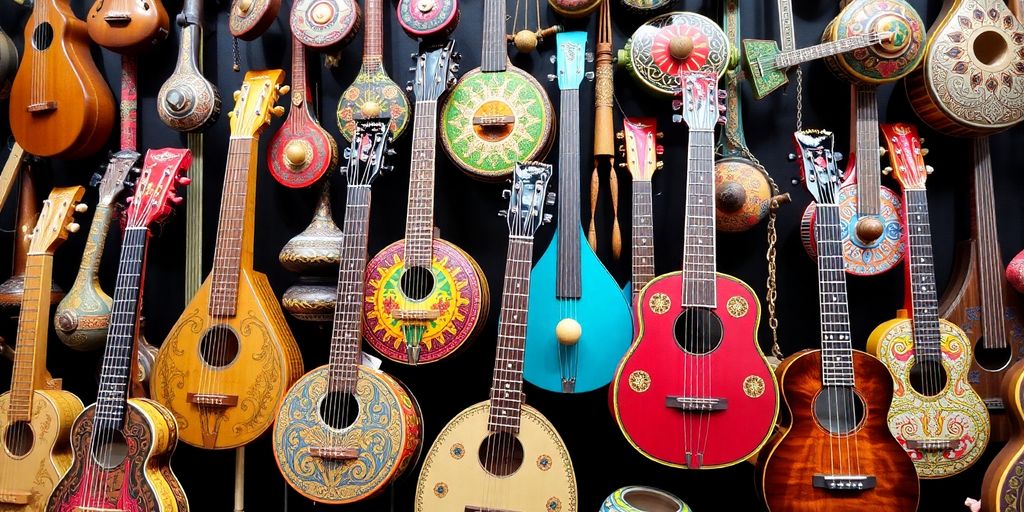
So, I recently checked out the Musical Instrument Museum, or MIM, in Phoenix. It’s pretty cool, honestly. It’s like a trip around the world, but with music. They have instruments from pretty much every country you can think of, and it’s not just the fancy ones you see in orchestras. They’ve got everyday instruments too, which is neat. The whole place is set up really well, making it easy to explore the different music traditions from all over the globe. It’s definitely a place worth visiting if you’re in the area.
Key Takeaways
- The Musical Instrument Museum (MIM) boasts a vast collection of instruments from every country, offering a global musical journey.
- The museum is organized into five geographic galleries, allowing visitors to explore diverse musical traditions through immersive audio-visual displays.
- MIM was founded with a vision to showcase everyday instruments played worldwide, focusing on a unique guest experience.
- Highlights include the Artist Gallery, showcasing instruments by famous musicians, and exhibits on electronic music innovations.
- Planning your visit is straightforward with information on location, hours, dining, and guest services readily available.
Discover the World Through Music

Get ready to take a trip around the globe without ever leaving Phoenix. The Musical Instrument Museum (MIM) is a place where you can really explore different cultures and sounds. It’s not just about looking at old instruments; it’s about experiencing the music that shaped societies and continues to inspire people today. You can truly feel the pulse of the world through its diverse melodies. It’s a unique spot that connects you to humanity’s shared love for music.
An Expansive Global Collection
The MIM houses an incredible collection of instruments from every corner of the earth. We’re talking thousands of items, each with its own story. It’s amazing to see the sheer variety, from tiny flutes to massive drums. The way different cultures create sound is just fascinating.
Every Country Represented
Seriously, they’ve got something from everywhere. Whether you’re interested in the music of Asia, Africa, Europe, or the Americas, you’ll find instruments that represent those places. It’s a fantastic way to learn about countries you might not know much about, all through their musical heritage. You can even find information on music rolls that were used in early mechanical instruments.
A Unique Museum Experience
What makes the MIM stand out is how they present everything. It’s not just static displays. They use technology to bring the instruments to life, letting you hear what they sound like in their original settings. It’s a really engaging way to learn and appreciate the music.
Exploring the Geographic Galleries
Get ready to take a trip around the globe without ever leaving Phoenix. The Music Instrument Museum’s Geographic Galleries are where the real adventure begins. You’ll find instruments from every corner of the planet, organized by region. It’s like a world tour for your ears and eyes.
Journey Through Five Regions
The museum is smartly divided into five major geographic areas: Africa and the Middle East, Asia, Europe, Latin America, and Oceania and the United States. Each section is a deep dive into the musical life of that part of the world. You can spend hours just in one area, soaking it all in. It’s a fantastic way to see how music connects us all, no matter where we live.
Immersive Audio-Visuals
What makes these galleries so special is how they bring the music to life. As you walk through, you’ll see displays of instruments in their cultural settings. Then, with the push of a button on your audio device, you can hear the instruments being played. It’s not just looking at old instruments; it’s hearing them sing, chant, and roar. This makes the experience really come alive, giving you a feel for the music’s context and spirit. It’s a truly sensory-rich experience.
Discover Diverse Musical Traditions
From the intricate string work of the Middle East to the vibrant percussion of Latin America, the variety is astounding. You can learn about the instruments used in traditional ceremonies, everyday life, and major celebrations. It’s a chance to explore new interests and discover cultural connections through music. You might find yourself humming a tune from a country you’d never even thought about before. The sheer diversity of musical traditions on display is a testament to human creativity. You can learn about the instruments used in traditional ceremonies, everyday life, and major celebrations. It’s a chance to explore new interests and discover cultural connections through music. You might find yourself humming a tune from a country you’d never even thought about before. The sheer diversity of musical traditions on display is a testament to human creativity. This is a great place to learn about the Musical Instrument Museum and its global collection.
The Inspiration Behind the MIM
When Bob Ulrich, then CEO of Target Corporation, first envisioned the Musical Instrument Museum (MIM), he wanted something different. Many museums at the time focused heavily on historical, mainly Western classical instruments. Ulrich, however, was inspired to create a new kind of museum that would highlight the instruments people use every day all around the globe. This vision was all about the guest experience, shaping every decision made during the museum’s development.
A Vision for a New Kind of Museum
Ulrich’s goal was to move away from the traditional museum model. He wanted to celebrate the vast diversity of music and instruments played by people in their daily lives, not just those found in concert halls. This approach aimed to make music more accessible and relatable to everyone.
Focus on Everyday Instruments
The MIM’s collection intentionally includes instruments that are part of everyday life for people in different cultures. This means you’ll find everything from simple folk instruments to more complex traditional ones, all representing the rich tapestry of global music. It’s a celebration of music as a universal human experience.
Prioritizing the Guest Experience
From the very beginning, the museum was designed with the visitor in mind. This focus is evident in the immersive audio-visual displays, the interactive elements, and the comfortable atmosphere. The aim was to create a place where everyone, regardless of their musical background, could feel engaged and inspired. The museum’s layout and exhibits are meant to be intuitive and enjoyable, making it easy for visitors to explore and connect with the music and cultures presented. It’s a place where you can truly feel the pulse of global music.
The museum’s commitment to the guest experience is clear in its thoughtful design and engaging exhibits, making it a welcoming destination for all.
This approach has resulted in a museum that is not only educational but also incredibly fun and engaging. It’s a place that truly brings the world of music to life for every visitor, whether they are seasoned musicians or just starting to explore. The MIM truly offers a unique way to connect with different cultures through the universal language of music. It’s a fantastic example of how museums can adapt to create more meaningful interactions with their collections, much like the innovative student-made furniture exhibit at Museum London.
Highlights of the Musical Instrument Museum
The Artist Gallery
The Artist Gallery at the MIM is a really special place. It’s not just about looking at instruments; it’s about connecting with the people who made music with them. You’ll find displays dedicated to famous musicians and artists from all sorts of genres. It’s a great way to see how different artists used instruments to create their unique sounds. This gallery really brings the history of music to life.
Electronic Music Innovations
For anyone interested in how technology has changed music, this section is a must-see. It traces the development of electronic instruments, from early experiments to the sophisticated gear used today. You can learn about the pioneers who pushed the boundaries of sound and see some of the groundbreaking instruments they created. It’s fascinating to see how these innovations have shaped modern music.
Pioneering Synthesizers
This part of the museum focuses specifically on synthesizers, those amazing machines that can create a vast range of sounds. You’ll get to see some of the very first synthesizers ever made, alongside more modern versions. It’s a journey through the evolution of electronic sound creation.
The MIM does a fantastic job of showing how these electronic instruments, often seen as purely technical, are deeply tied to artistic expression and cultural movements. It’s more than just circuits and knobs; it’s about the sounds that changed the world.
Here’s a quick look at what you might find:
- Early analog synthesizers
- Drum machines that defined genres
- Keyboards used by iconic musicians
- Interactive displays explaining how synthesizers work
It’s a really engaging part of the museum, especially if you’re curious about the science and art behind electronic music. You can even learn about some of the early string instruments that paved the way for new sounds.
Planning Your Visit to the MIM
Thinking about heading to the Musical Instrument Museum? It’s a fantastic idea! To make sure your trip goes smoothly, here’s a breakdown of what you need to know before you arrive. Getting there is pretty straightforward. The museum is located at 4725 E. Mayo Blvd., Phoenix, AZ 85050, right up in the northern part of the city, close to the Loop 101. Parking is free and the lot entrance is on Mayo Blvd. It’s a good idea to check the museum’s website for the most current hours before you go.
Location and Directions
Museum Hours and Dining
The museum is open every day from 9 a.m. to 5 p.m. They are closed on Thanksgiving Day. If you get hungry, Café Allegro serves lunch from 11 a.m. to 3 p.m., and the Beats Coffee Bar is open the whole time the museum is. So, you won’t go hungry!
Contacting Guest Services
If you have any questions or need a hand with anything, the Guest Service Team is there to help. You can reach them by phone at +1 480-478-6000 or shoot them an email at guestservice@MIM.org. They’re a great resource for planning your visit to the Musical Instrument Museum.
Planning ahead really makes a difference. Knowing the hours, how to get there, and who to call if you need help means you can just focus on enjoying all the amazing music and instruments when you arrive.
Enhancing Your Museum Experience

To really get the most out of your visit to the Musical Instrument Museum (MIM), there are a few things you can do. It’s not just about looking; it’s about listening and interacting. The museum provides a really unique way to connect with music from all over the globe.
Utilizing Audio Devices
When you arrive, you’ll be given a headset and a receiver. Don’t just shove them in your pocket! These are your keys to unlocking the sounds of the instruments. As you walk up to a display, the audio associated with that instrument will automatically play through your headset. It’s pretty neat how it works – no fumbling for buttons. Just get close, and the music starts. It makes the whole experience so much richer, letting you hear examples of everything from a giant octobass to delicate flutes. It’s a game-changer for appreciating the diversity of musical traditions.
Exploring Special Exhibitions
Beyond the permanent geographic galleries, MIM often hosts special exhibitions. These can focus on specific genres, historical periods, or even particular instrument makers. Checking what’s on during your visit can add another layer to your exploration. Sometimes these exhibitions have unique interactive elements or rare instruments that aren’t part of the main collection. It’s always worth seeing if there’s something extra that catches your eye (and ear!).
Interactive Elements for All Ages
MIM isn’t just for quiet observation. They’ve put a lot of thought into making it engaging for everyone. You’ll find areas where you can try out instruments yourself, like percussion stations or even opportunities to play larger instruments. These hands-on moments are fantastic for kids and adults alike, helping to make the music more tangible. It’s a great way to break up the viewing and listening, offering a chance to actively participate in the world of music. You can even try out some instruments in the "Experience" gallery.
The museum’s design really encourages you to engage with the exhibits. It’s clear they wanted people to not just see, but to hear and even feel the music. This approach makes it a really memorable visit, especially if you’re not a seasoned musician yourself.
A Must-Visit Destination
So, if you’re looking for a place that’s genuinely interesting and offers something new around every corner, the Musical Instrument Museum is definitely worth checking out. It’s more than just looking at old instruments; it’s like taking a trip around the globe without ever leaving Phoenix. You get to hear how music sounds in different places and learn about the people who play it. Honestly, it’s a pretty cool experience, and I’d go back again if I had the chance.
Frequently Asked Questions
What kind of instruments can I see at the MIM?
The Musical Instrument Museum (MIM) has instruments from every country in the world, covering a huge range of musical styles and traditions. It’s a fantastic place to learn about different cultures through their music.
How is the museum organized?
Yes, the museum is organized into five main areas based on different parts of the world. This makes it easy to explore music from places like Asia, Africa, Europe, and more.
How can I hear the instruments?
The MIM uses special headphones that let you hear recordings of the instruments as you see them. It really brings the exhibits to life and helps you understand how the instruments sound.
Is there anything about famous musicians?
The museum has an Artist Gallery that shows instruments played by famous musicians. It’s a cool way to connect with the music you might already know and see the tools they used.
Does the museum cover electronic music?
Yes, the MIM has exhibits on electronic music and includes early synthesizers, which were a big deal in music history. It shows how technology has changed music.
Where is the museum located and what are the hours?
The museum is located at 4725 E. Mayo Blvd., Phoenix, AZ 85050. Parking is free, and it’s easy to get to by car. You can also check their website for directions and hours.





